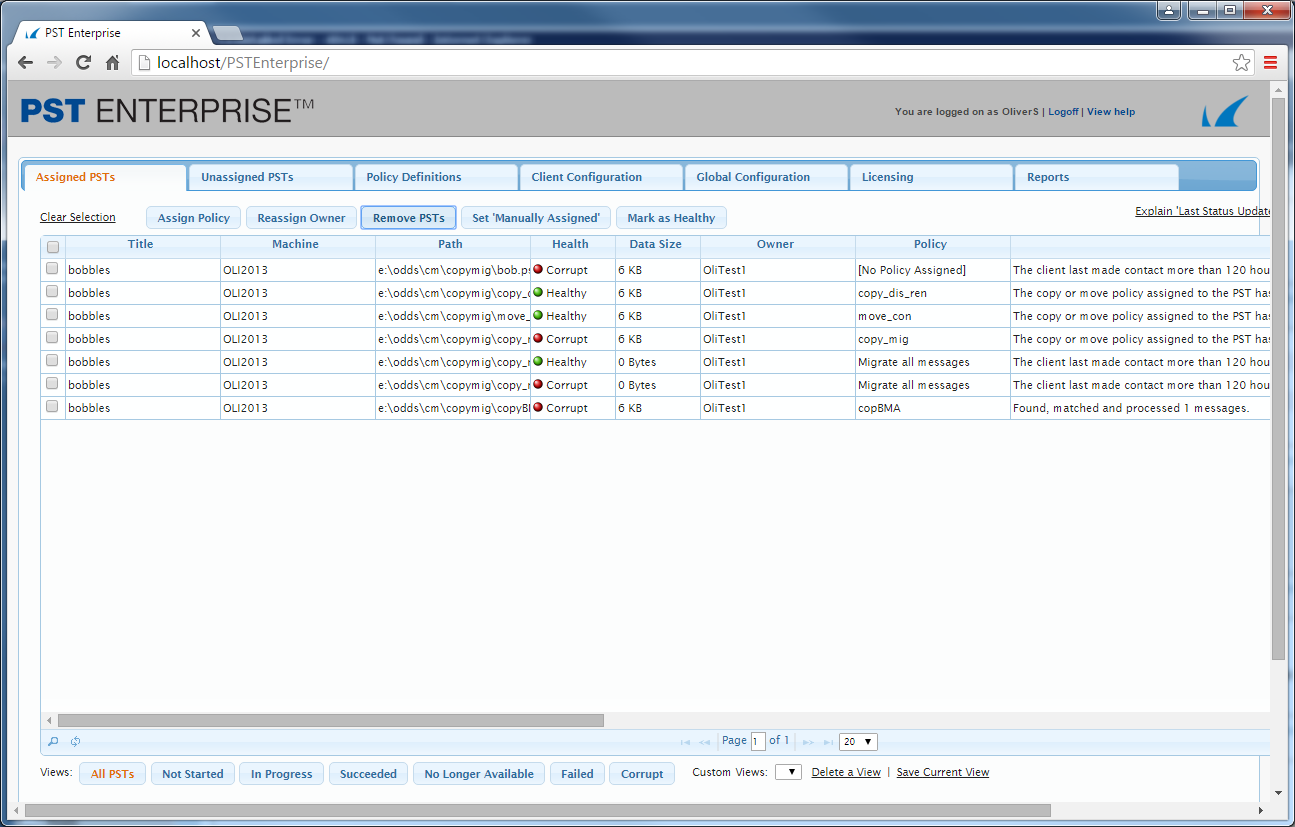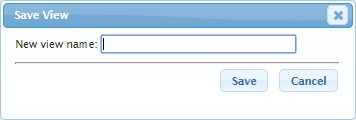This article refers to the Barracuda PST Enterprise version 5.1 or higher.
For a list of error messages, refer to the article PST Status Messages.
Once a PST file has been discovered by the PST Enterprise Client and is assigned an owner, either automatically through the PST Enterprise Client application or manually via the website, it displays in the Assigned PSTs tab:
Use this tab to assign policies to PST files to be used to process items and set a schedule for the start and end times during which the PST Enterprise Client applies the policy.
PST files are discovered either connected to Outlook or in the file system. If they are found by both methods, the connection to Outlook takes prominence and the How assigned column displays as Found Attached. This means the mailbox to which Outlook was connected is considered the correct mailbox for the PST file.
PST Health
The Health column indicates the health of a PST. If there were problems opening and searching the PST (such as if the access caused a crash in the PST Processor) the PST will be marked as 'Corrupt' in this column, in which case PST Enterprise will not open or process it. You should examine the PST, and make any steps necessary to repair it, such as using ScanPST.exe supplied with Outlook. If you have repaired the PST you can select it and click the 'Mark as Healthy' button to cause the PST Processor to retry processing it.
Take Actions on Discovered PST Files
To take actions on PST files that display in this tab, select one or more PST files, and select the desired action:
- Assign Policy – Policy Schedules for a PST on the Assign Policy dialog.
Reassign Owner – Click to reassign the owner of a PST file found in the file system.
- Remove PSTs – Removes the application’s knowledge of the selected PST files. Data about the selected PST files is removed, and the next time the PST Enterprise Client runs and rediscovers the removed files, they are once again added.
- Set 'Manually Assigned' – Allows you to reassign a PST file connected to an Outlook mailbox.
Restricting PST Files
Use the Views options to restrict the discovered PST files based on the selected criteria and define custom views based on your own search criteria.
- All PSTs – Default setting. Returns all discovered PST files.
- Not Started – Returns PST files that do not have a policy assigned and do not meet the condition Succeeded, No Longer Available, or Failed.
- In Progress – Returns PST files that have a policy assigned and that do not meet the condition Succeeded, No Longer Available, or Failed.
- Succeeded – Returns PST files that have been assigned an owner mailbox and have completed successfully.
- No Longer Available – Returns PST files that were previously found can no longer be found.
- Failed – Returns PST files where processing cannot be completed.
- Corrupt – Returns PST files marked as corrupt.
Clear Selection
Click to clear all selected PST files in the table.
Explain Last Status Update Messages
The Last Status Update column in the table displays an abbreviated description of the status. For a list of the complete status messages, click the Explain Last Status Update Messages link, or view the article PST Status Messages.
Export Data
Export CSV File – Generate a .csv file containing all PSTs matching the current filter criteria. The .csv file can be opened and edited in Microsoft Excel.
Export with History – Generate a .csv file containing all PSTs matching the current filter criteria. Each row in the .csv file contains PST file details and the details of one row of the processing history for that PST.
Click Export to CSV to generate a file containing all PSTs matching the current filter criteria.
- Click Export to CSV at the top right of the screen.
Save the .csv file, and then open the file in an editor, for example, Microsoft Excel.
Custom Views
To define a custom view based on your own criteria,
- Click the Find records (
 ) icon at the bottom left of the screen.
) icon at the bottom left of the screen. - The Search dialog box displays:

- Define your search criteria, click Find, and then close the Search dialog box.
- Click Save Current View; the Save View dialog box displays:

- Enter a name for the view, and then click Save.
- Click OK in the confirmation dialog box; the view is added to the Custom Views drop-down menu.
- To delete a custom view, click Delete a View.
- The Delete View dialog box displays. Select the view you want to delete from the drop-down menu, and then click Delete.
- Click OK in the confirmation dialog box; the view is removed from the Custom Views drop-down menu.
